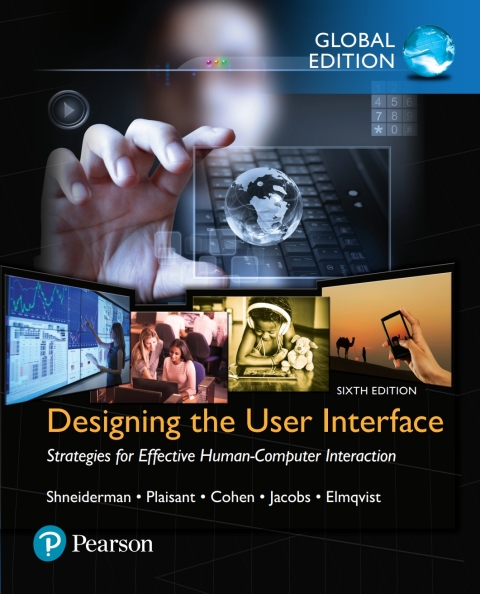Description
Efnisyfirlit
- Title Page
- Copyright Page
- Preface
- Acknowledgments
- About the Authors
- Brief Contents
- Contents
- Preface
- About the Authors
- Part 1: Introduction
- Chapter 1: Usability of Interactive Systems
- 1.1. Introduction
- 1.2. Usability Goals and Measures
- 1.3. Usability Motivations
- 1.4. Goals for Our Profession
- Chapter 2: Universal Usability
- 2.1. Introduction
- 2.2. Variations in Physical Abilities and Physical Workplaces
- 2.3. Diverse Cognitive and Perceptual Abilities
- 2.4. Personality Differences
- 2.5. Cultural and International Diversity
- 2.6. Users with Disabilities
- 2.7. Older Adult Users
- 2.8. Children
- 2.9. Accommodating Hardware and Software Diversity
- Chapter 3: Guidelines, Principles, and Theories
- 3.1. Introduction
- 3.2. Guidelines
- 3.3. Principles
- 3.4. Theories
- Part 2: Design Processes
- Chapter 4: Design
- 4.1. Introduction
- 4.2. Organizational Support for Design
- 4.3. The Design Process
- 4.4. Design Frameworks
- 4.5. Design Methods
- 4.6. Design Tools, Practices, and Patterns
- 4.7. Social Impact Analysis
- 4.8. Legal Issues
- Chapter 5: Evaluation and the User Experience
- 5.1. Introduction
- 5.2. Expert Reviews and Heuristics
- 5.3. Usability Testing and Laboratories
- 5.4. Survey Instruments
- 5.5. Acceptance Tests
- 5.6. Evaluation during Active Use and Beyond
- 5.7. Controlled Psychologically Oriented Experiments
- Chapter 6: Design Case Studies
- 6.1. Introduction
- 6.2. Case Study 1: Iterative Design Evaluation of Automated Teller Machines (ATMs)
- 6.3. Case Study 2: Design Consistency at Apple Computer
- 6.4. Case Study 3: Data-Driven Design at Volvo
- 6.5. General Observations and Summary
- Part 3: Interaction Styles
- Chapter 7: Direct Manipulation and Immersive Environments
- 7.1. Introduction
- 7.2. What Is Direct Manipulation?
- 7.3. Some Examples of Direct Manipulation
- 7.4. 2-D and 3-D Interfaces
- 7.5. Teleoperation and Presence
- 7.6. Augmented and Virtual Reality
- Chapter 8: Fluid Navigation
- 8.1. Introduction
- 8.2. Navigation by Selection
- 8.3. Small Displays
- 8.4. Content Organization
- 8.5. Audio Menus
- 8.6. Form Fill-in and Dialog Boxes
- Chapter 9: Expressive Human and Command Languages
- 9.1. Introduction
- 9.2. Speech Recognition
- 9.3. Speech Production
- 9.4. Human Language Technology
- 9.5. Traditional Command Languages
- Chapter 10: Devices
- 10.1. Introduction
- 10.2. Keyboards and Keypads
- 10.3. Pointing Devices
- 10.4. Displays
- Chapter 11: Communication and Collaboration
- 11.1. Introduction
- 11.2. Models of Collaboration
- 11.3. Specific Goals and Contexts
- 11.4. Design Considerations
- Part 4: Design Issues
- Chapter 12: Advancing the User Experience
- 12.1. Introduction
- 12.2. Display Design
- 12.3. View (Window) Management
- 12.4. Animation
- 12.5. Webpage Design
- 12.6. Color
- 12.7. Nonanthropomorphic Design
- 12.8. Error Messages
- Chapter 13: The Timely User Experience
- 13.1. Introduction
- 13.2. Models of System Response Time (SRT) Impacts
- 13.3. Expectations and Attitudes
- 13.4. User Productivity and Variability in SRT
- 13.5. Frustrating Experiences
- Chapter 14: Documentation and User Support (a.k.a. Help)
- 14.1. Introduction
- 14.2. Shaping the Content of the Documentation
- 14.3. Accessing the Documentation
- 14.4. Reading from Displays versus Reading from Paper
- 14.5. Online Tutorials and Animated Demonstrations
- 14.6. Online Communities and Other Avenues for User Support
- 14.7. The Development Process
- Chapter 15: Information Search
- 15.1. Introduction
- 15.2. Five-Stage Search Framework
- 15.3. Dynamic Queries and Faceted Search
- 15.4. Command Languages and “Natural” Language Queries
- 15.5. Multimedia Document Search and Other Specialized Search
- 15.6. The Social Aspects of Search
- Chapter 16: Data Visualization
- 16.1. Introduction
- 16.2. Tasks in Data Visualization
- 16.3. Visualization by Data Type
- 16.4. Challenges for Data Visualization
- Afterword: Societal and Individual Impact of User Interfaces
- A.1. Future Interfaces and Grand Challenges
- A.2. Ten Plagues of the Information Age
- Name Index
- Subject Index
- Credits






Reviews
There are no reviews yet.